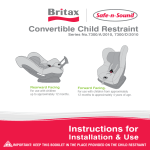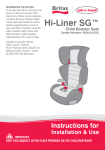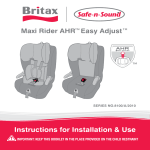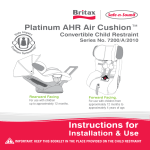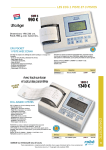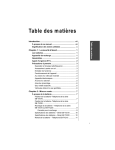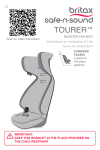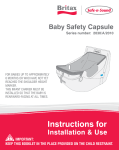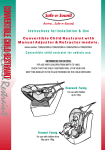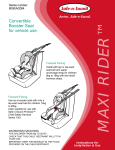Download Britax Encore 10 Instruction manual
Transcript
Encore 10™ Child Booster Seat Series Number: 4900/A/2010 IMPORTANT: KEEP THIS BOOKLET IN THE POCKET UNDER THE BASE OF THE CHILD RESTRAINT Instructions for Installation & Use - Series No. 4900/A/2010 INDEX Page 2 3 INTRODUCTION 4 WARNINGS 6 SHOULDER HEIGHT MARKERS AND A GROWING CHILD 7 SHOULDER HEIGHT MARKERS AND THE NEXT SEAT 8 SPECIAL FEATURES 10 SUITABLE FOR USE 11 HOW TO SETUP 15 HOW TO INSTALL 16 HOW TO USE 20 HOW TO INSTALL WITH A CHILD HARNESS 31 TO REMOVE RESTRAINT FROM VEHICLE 32 CARE & MAINTENANCE 36 ACCESSORIES 38 INSTALLATION OF CAR ANCHOR FITTING 41 IN CASE OF ACCIDENT Instructions for Installation & Use - Series No. 4900/A/2010 INTRODUCTION This Booster Seat is designed for use by children from approximately 4 years of age up to approximately 8 to 10 years of age in vehicles using a lap-sash seatbelt or with a seatbelt and Child Harness. It must not be used with just a lap only seatbelt as the upper body of the child is not protected. This Booster Seat is fitted with the VERSATETHER™ catch that allows it to be used with a child harness. Only the Safe-n-Sound™Protecta PLUS™Harness Series 220/2010 or Babylove EzyGo Harness™Series BL220/2010 child harnesses are suitable for use with this product. No other Harness is suitable with this booster seat unless advised by Safe-n-Sound. A child who is not tall enough to reach the upper shoulder height marker in their seat with in-built harness will be too small for this booster seat. This booster seat should be used until the child no longer fits in this seat or the child can sit in the car’s seat with their lower leg able to hang over the car's seat cushion. This booster seat is not designed to be reclined. You purchased a model with the added protection of a Side Impact Cushion Technology™ headrest you can see the Side Impact Cushion fitted on the sides of the headrest. There is no installation or assembly required to activate the Side Impact Cushion, it only functions in a side crash to provide additional protection to the occupant. THIS RESTRAINT MUST BE ATTACHED TO A CHILD RESTRAINT ANCHORAGE POINT IN THE CAR. REFER TO CAR OWNER’S HANDBOOK FOR LOCATION OF ANCHORAGE POINTS. REFER TO A CHILD RESTRAINT FITTING STATION IF NO ANCHORAGE POINTS ARE IN THE MOTOR CAR. CAREFULLY READ ALL THE INSTRUCTIONS FOR INSTALLATION. IN THE EVENT OF DOUBT ABOUT THE METHOD OF INSTALLATION, CONSULT SAFE-N-SOUND OR A CHILD RESTRAINT FITTING STATION AUTHORISED BY A RELEVANT TRANSPORT AUTHORITY. IN NEW ZEALAND, CONTACT THE AGENT FOR THE VEHICLE. THIS RESTRAINT MUST BE USED IN CARS WITH FORWARD FACING SEATS WITH A LAP-SASH SEATBELT OR WITH A SEATBELT AND CHILD HARNESS. No child restraint can guarantee absolute protection from injury in every crash. However, to ensure that your child gets all the protection designed into the restraint PLEASE READ AND FOLLOW THESE INSTRUCTIONS EXACTLY. The instruction manual is to be stored in a pocket under booster seat see page 8 for details. Instructions for Installation & Use - Series No. 4900/A/2010 3 • Use the restraint exactly as shown in the instructions. • Supervision of children is needed because they may be able to undo buckles and adjusters. • DO NOT LEAVE CHILDREN UNATTENDED IN THE CAR. • Do not alter or modify this restraint. Use only recommended parts and accessories. • Repairs must only be done by the manufacturer or agent. • Do not allow the restraint to come into contact with polishes, oils, bleach and other chemicals. • Destroy the restraint if it has been in a severe crash, even if no damage is visible. • DO NOT USE WITH JUST A LAP BELT. You must use with lap-sash seatbelt, or with a seatbelt and child harness. • The lap part of the seatbelt must be firmly across the thighs and the sash straps fitted diagonally across the chest and on the shoulder. • If used with a child harness, the lap strap of the seatbelt must be adjusted firmly first, and then the harness, so that the lap-strap is not lifted off the child’s lap when the harness is adjusted. • DO NOT USE THIS RESTRAINT WITHOUT THE COVER. • IF AN AIRBAG IS FITTED IN THE SEATING POSITION WHERE THE CHILD RESTRAINT IS TO BE FITTED, FOLLOW THE VEHICLE MANUFACTURER’S WARNINGS AND INSTRUCTIONS. • Regularly check the restraint components, straps and other fitments for correct function, cracking & condition. Seek prompt repair. • Straps may be damaged by unsecured cargo in a collision. Secure or remove hazardous cargo before using this strap. Hatch-back or wagon: Do not use the child restraint where this strap may fall into a split in the seat back. Always attach hook and remove slack. 4 Instructions for Installation & Use - Series No. 4900/A/2010 • Securely stow all heavy objects, feeding bottles, cup holders, etc that could become missiles during an accident and cause injury to any occupant. • The restraint should not be purchased or sold as a second hand item. It is recommended not to use child restraints older than 10 years as the protection in an accident may be reduced. • THIS RESTRAINT IS NOT SUITABLE FOR USE WHERE THE ANCHORAGE STRAP MAY FALL INTO A SPLIT IN THE SEAT BACK. (E.G. HATCHBACK OR WAGON). • Do not lift the seat by the headrest or the Side Wings. • Do not store in areas that may get hot, like in car boots, roof space, beside shed walls which get hot in summer. Do not place heavy items on top of the seat as this may distort the plastic. : DO NOT LEAVE CHILDREN UNATTENDED IN THE CAR. Instructions for Installation & Use - Series No. 4900/A/2010 5 SHOULDER HEIGHT MARKERS AND A GROWING CHILD Label B Label A upper Height label will be behind the child’s neck. SMALLER CHILD TALLER CHILD From approximately 4 years of age. To approximately 8 to 10 years of age. Shoulders must not be below the Lower Shoulder Height Marker when the headrest is the lowest position. Shoulders must not be above the Upper Shoulder Height Marker when the headrest is in the highest position. Label B Label A NOTE: These heights also apply if you are using a Child Harness with the booster seat. Front of Vehicle 6 Instructions for Installation & Use - Series No. 4900/A/2010 SHOULDER HEIGHT MARKERS AND THE NEXT SEAT IMPORTANT: Follow this advice. Label A Smaller Child - Lower Marker Label B Larger Child - Upper Marker A Child who has outgrown their child restraint with in-built harness will have their shoulders in line or above the lowest shoulder height marker (label A) of this booster seat with the headrest in the lowest position. If the child’s shoulders are below this marker the child needs to stay in their child restraint with an in-built harness. The seat can be used until the child’s shoulders reach the Upper Marker (label B) with the headrest fully raised. Usually the shoulders will contact the bottom of the headrest, it is then time to move to the next form of restraint. For maximum safety continue to use this seat as long as the child fits in the seat. Next type of restraint that can be used in the car for your child. When your child has outgrown the seat, you can then either use: Just the car's lap-sash seatbelt. Or you can use a Child Harness and lap seatbelt. Lap seatbelts can be dangerous without a Child Harness. Instructions for Installation & Use - Series No. 4900/A/2010 7 SPECIAL FEATURES 17 18 19 20 1 Front of Vehicle 2 12 3 11 16 4 5 15 6 7 8 14 9 13 10 Encore 10™ Child Booster Series Number: Seat 4900/A/2010 11 12 Instruction book located under booster in pocket 8 Rear View of Booster Seat Instructions for Installation & Use - Series No. 4900/A/2010 SPECIAL FEATURES 1. Car's Anchor Fitting 2. Side Impact Cushion (one each side) 3. Adjustable Height Headrest 4. Car's Seatbelt 5. Adjustable Side Wings 6. Padded cover for comfort 7. Booster Seatbelt path indicator 8. Pocket 9. Cup holder (if supplied) 10. Headrest Adjustment handle 11. Sash Guide (one each side of headrest) 12. Shoulder slots for use with Child Harness 13. Instruction Book location 14. Adjustment knob for base adjusting 15. SLIDEGUARD™ Lap belt positioning Clip 16. Shoulder Height Markers 17. Upper Anchorage Strap Adjuster 18. Upper Anchorage Storage Band 19. Adjustable Upper Anchorage Strap 20. Attachment Clip Instructions for Installation & Use - Series No. 4900/A/2010 9 SUITABLE FOR USE To be used with either a lap-sash seatbelt or an add-on accessory Child Harness by children whose shoulders are above the Lower Shoulder Height Marker with head restraint in the lowest position (approximately 4 years of age) until their shoulders reach the Upper Shoulder Height Marker with head restraint in the highest position (approximately 8 to 10 years of age). Continue to use this booster seat until the child reaches this limit. Children are safest in a booster seat until their shoulders reach the Upper Shoulder Height Marker of the booster seat. Do not use this restraint until child’s shoulders are above the Lower Shoulder Height Marker with the head restraint in the lowest position. THIS RESTRAINT MUST BE USED IN CARS WITH FORWARD-FACING SEATS WITH A LAPSASH SEATBELT OR WITH A SEATBELT AND CHILD HARNESS. • If your vehicle is not fitted with an anchor point, please contact a Safety Restraint Fitting Station authorised by the relevant State Government Body for correct fitment of the restraint. In New Zealand contact the agent for the vehicle. The upper anchorage strap must be attached to an anchorage point using an extension strap if necessary. • DO NOT USE WITH JUST A LAP BELT. You must use with lap-sash seatbelt, or with a seatbelt and Child Harness. • Do not use the restraint without the Upper Anchorage Strap attached. • Do not use in a front seat, unless it has a child restraint anchorage point and your child is over 4 years of age or in accordance with the applicable Road Rules in your region. • Do not use on any vehicle seat which faces sideways or rearwards. • Only use Safe-n-Sound™replacement covers for this Booster seat to ensure all safety information is provided. 10 Instructions for Installation & Use - Series No. 4900/A/2010 HOW TO SETUP UNFOLDING THE BOOSTER SEAT If the seat is in a folded position, grip the Booster seat back and seat base and unfold till you hear it lock into position. Check that the seat has locked into position. Seat back CAUTION: DO NOT PLACE FINGERS IN BETWEEN SEAT BACK & SEAT BASE WHEN FOLDING OR UNFOLDING. Seat base FOLDING THE BOOSTER SEAT To store the Booster seat, push to fold the seat forward. ADJUSTING THE CAR'S SEAT BACKREST The backrest pivots freely so as to match the car seat back angle. Move the restraint back until it is touching the car’s seat back. If the vehicle seat back angle is adjustable put it in the normal upright mode. Normal backrest angle Backrest angle too reclined Instructions for Installation & Use - Series No. 4900/A/2010 11 HOW TO SETUP ADJUSTING THE HEADREST A. The headrest can be adjusted to lock into different height locations. This can be done with the child in the seat. B. Hold backrest as shown and squeeze the headrest adjustment handle at the back of the headrest with the other hand, to move the headrest up or down. A CAUTION: Keep hands away from gap at the back of the lower backrest whilst adjusting. C. Adjust the headrest height so that the bottom of the sash guide is level with or just above your child’s shoulder (but not more than 30mm above). Less than 30mm Greater than 30mm B C D. When the headrest is in the correct position let go of the headrest adjustment handle and ensure it has locked into place. Do not adjust the headrest by pulling on the Side Impact Cushion. 12 Instructions for Installation & Use - Series No. 4900/A/2010 HOW TO SETUP ADJUSTING BASE EXTENSION This booster seat has a base extension which can be easily adjusted by rotating the knob. This is to accommodate the leg length of larger children. Rotate to lengthen base When should the base be extended? Extend the base so that the front edge of the base is close to the back of your child’s knees. The upper thigh section of their legs will be supported and the seating position is made more comfortable by reducing pressure points. ADJUSTING THE SIDE WINGS The Adjustable Side Wings provide more width for a Larger child or can be kept narrow to reduce the width of the Booster seat. To adjust, hold seat or headrest with one hand and use the other hand to lift up side wing and rotate, let it click down into place, then do the same for the other side wing. When should the wings be adjusted? 2. Push back 1. Lift When your childs arms and shoulders require more room within the seat, adjust the expandable side wings to the widest position to create more space for your child. Alternatively keep narrow if there are width restrictions in the car. Instructions for Installation & Use - Series No. 4900/A/2010 13 HOW TO SETUP ADJUSTING THE SLIDEGUARD™CLIP POSITION Adjuster The crotch strap length adjuster can be found under the seat located by opening the instruction book flap. A. Adjust the crotch straps for the SLIDEGUARD™clip to the correct length for your child. It should be kept as low as possible to keep the lap portion of the seatbelt engaged low-over the hips. Ensure the SLIDEGUARD™clip does not push into your child's thighs as this may cause discomfort. Under booster seat ALWAYS USE THIS DEVICE. B. To change the length of the crotch strap, thread through the adjuster in the direction of the arrows shown below. TO SHORTEN TO LENGTHEN Lower edge of SLIDEGUARD™ Clip, level with top of thighs. IMPORTANT : You must adjust the crotch strap to the correct length for your child before installing the restraint as it cannot be adjusted in the car. Always return the crotch strap to its original shorter length when using the seat with a smaller child. The SLIDEGUARD™clip must always be positioned low down on your child's body - it will not connect correctly with the seatbelt if it is too high. DO NOT attempt to remove or dismantle the crotch strap. 14 Instructions for Installation & Use - Series No. 4900/A/2010 HOW TO INSTALL INSTALLING INTO VEHICLE A. Position the restraint in the car forward facing in the chosen seating position. Adjust the headrest to the correct height for your child (refer to page 11). Ensure the seating position has a child restraint anchorage fitting. Refer to the car owner's handbook. If no fitting is provided refer to anchor fitting information on pages 38 to 40. B. Lengthen the upper anchorage strap by removing the excess strap from the storage band, then press the adjuster button (1) and pull the strap with the attachment clip (2). Hook the attachment clip to the anchor fitting. Make sure to remove any twists from the Upper Anchorage Strap. 1 2 Storage Band 3 A Attachment Clip Anchor Fitting B Pull to remove slack C. Tighten Adjustable Upper Anchorage Strap by pulling adjusting strap (3) to remove slack. Do not tighten causing the restraint base to lift off the vehicle seat. C Always attach hook and remove slack. D. Fold up excess strap and use storage band to neatly store away from child's reach and secure with the hook and loop storage strap. Storage Band Fold up excess strap and store with the storage band. D Instructions for Installation & Use - Series No. 4900/A/2010 15 HOW TO USE USING LAP-SASH SEATBELT WITHOUT CHILD HARNESS A. Place the restraint Forward Facing in your car, ensuring it is pushed firmly into the car seat and the backrest touches the backrest of the car seat. Sit your child on the seat. Ensure the headrest is set to the correct height for your child (See page 12). A B. Position the lap-sash belt over the child following the red BOOSTER SEATBELT PATH labels, ensuring the lap portion is positioned over the lap belt guides and into the lap recess area on both sides. Fit the sash portion of the belt through the sash guide on the headrest as shown. Lap part of seat belt in recess area. Sash guide ALWAYS USE THIS SASH GUIDE 16 Instructions for Installation & Use - Series No. 4900/A/2010 B HOW TO USE C. Engage seatbelt buckle and tongue ensuring there are no twists in the belt. If the seatbelt buckle is adjustable, adjust the buckle as low as possible away from the child. Note: In some vehicles, the vehicle headrest may need to be raised or even removed to allow the booster seat to sit correctly, the vehicle headrest may also interfere with the routing of the upper anchorage strap. If removed, store the vehicle headrest in a safe place. Sash belt across the chest and through the sash guide Ensure both lap and sash belts are in recess area Ensure lap portion is in recess area Engage buckle D. Adjust lap and sash portion of seatbelt firmly but comfortably across the child’s lap and chest. E. Fit the SLIDEGUARD™clip to the lap belt. Ensure the bottom edge of the clip is in line with the thighs (see page 14 for adjustment steps). F. If using an Inertia Reel Retractor seatbelt, adjust the lap portion of the seatbelt firmly around the child and restraint, then let the slack sash portion retract up into the sash retractor. G. Fit the SLIDEGUARD™clip with the logo facing forward to the Lap Belt. ALWAYS USE THIS DEVICE G Instructions for Installation & Use - Series No. 4900/A/2010 17 HOW TO USE IMPORTANT : Always ensure the seatbelt is firmly fitted to the hips and thighs and the sash belt is diagonally across the chest. The SLIDEGUARD™clip MUST always be used when the child is using the booster seat as it ensures the lap belt is correctly positioned on the child's thighs and hips. A loose or poorly positioned lap belt can allow the lap belt to ride up into the abdomen and can cause serious injuries in a crash. Do not place seatbelt sash under the arm or behind the back. WARNING: A sash belt under the arm or behind the back is dangerous. SEATBELT UNDER THE ARM IS DANGEROUS 18 SEATBELT BEHIND THE BACK IS DANGEROUS Instructions for Installation & Use - Series No. 4900/A/2010 HOW TO USE Adjust headrest so it is close to the shoulders. Seatbelt across the chest and through the sash guides. Lap belt must always be firm on the thighs. The SLIDEGUARD™clip must be positioned on the lap belt so that the child cannot slump or slouch. NOTE: Seatbelt extenders should not be used if the seatbelt is not long enough to fit around the child. If a seatbelt extender is used then the seatbelt buckle must not be in contact with the child. TO REMOVE CHILD Disengage seatbelt tongue and buckle. Remove the lap portion of seatbelt from the SLIDEGUARD™clip, and remove belt from child. When Booster is not being used, secure in position, by engaging seatbelt over the booster seat or store in a safe place. Instructions for Installation & Use - Series No. 4900/A/2010 19 HOW TO INSTALL WITH A CHILD HARNESS USING WITH A CHILD HARNESS (PURCHASED SEPARATELY) This booster seat is only suitable for use with Safe-n-Sound™Protecta PLUS™Harness Series 220/2010 or Babylove EzyGo Harness™ Series BL220/2010. Refer to the instruction book supplied with the Child Harness for full details of using and installing the Child Harness. When installing the Child Harness into the vehicle and booster seat, connect the upper anchorage strap to the VERSATETHER™ Catch on the Booster Seat’s upper tether strap (as shown below). If required, use the extension strap supplied with the child harness for all other instances to attach the harness to anchor points in the luggage area such as the vehicle floor or ceiling. Not suitable for most other styles of child safety harnesses. INSTALLING SAFE-N-SOUND PROTECTA PLUS™CHILD HARNESS INTO VEHICLE WITHOUT EXTENSION STRAP Hook the Child Harness attachment clip (1) onto VERSATETHER™ Catch (2). Then hook attachment clip (3) onto anchor fitting. Ensure that none of the straps are twisted and not passing over any sharp edges. 1. Attachment Clip from Child Harness. 2. VERSATETHER™ Catch. 3. Booster seat Attachment Clip. 4. Anchor Fitting in the car. 1 3 1 2 Child Harness Attachment Clip attaches to the VERSATETHER™ Catch NOTE: Do not use the VERSATETHER™catch on the Child Harness Clip (1). VERSATETHER™catch (2) is only for use with a Child Harness. 20 Instructions for Installation & Use - Series No. 4900/A/2010 4 HOW TO INSTALL WITH A CHILD HARNESS INSTALLING SAFE-N-SOUND PROTECTA PLUS™ HARNESS WITH EXTENSION STRAP INTO VEHICLE An adjustable extension strap is supplied with the Child Harness. Hook the Safe-n-Sound Protecta PLUS™ Harness clip first onto the extension strap catch, then hook the extension strap hook onto the VERSATETHER™ Catch on the Booster Seat’s upper anchorage strap as shown below. Ensure that none of the straps are twisted or catching on sharp edges. Tighten the Booster Seat’s upper anchorage strap (refer to page 15) then remove excess slack from the extension strap by pulling the adjuster strap as illustrated below. 7 1 Pull to remove slack 2 7 3 6 5 Pull to remove slack 4 Rotate the Adjuster to lengthen Attachment Clip attaches to the VERSATETHER™ Catch Pull to lengthen To lengthen the Adjustable Extension strap rotate the adjuster and pull the main strap. Always attach the hook and remove the slack. Instructions for Installation & Use - Series No. 4900/A/2010 21 HOW TO INSTALL WITH A CHILD HARNESS CHOOSING METHOD OF INSTALLATION The Child Harness can be installed using either of the following methods. METHOD 1 : Using a lap sash seatbelt in conjunction with Gated 3-bar Slide (provided with the Child Harness) to convert to lap belt plus upper anchorage strap. METHOD 2 : Using lap seatbelt plus upper anchorage strap. Before installing the Child Harness determine which method of installation is required and follow instructions carefully. REFER TO THE Safe-n-Sound™Protecta PLUS™Harness Series 220/2010 or Babylove™ EzyGo Harness™ Series BL220/2010 INSTRUCTIONS FOR FULL DETAILS ON HOW TO USE AND INSTALL THE CHILD HARNESS. IMPORTANT : The SLIDEGUARD™clip MUST always be used when the child is using the booster seat with the child harness as it ensures the lap belt is correctly positioned on the child's thighs and hips. A loose or poorly positioned lap belt can allow the lap belt to ride up into the abdomen and can cause serious injures in a crash. 22 Instructions for Installation & Use - Series No. 4900/A/2010 HOW TO INSTALL WITH A CHILD HARNESS INSTALLING CHILD HARNESS INTO SEAT A. If the seat is fitted to the car, remove it as it will be easier to fit the child's harness. Cross Strap Left hand Strap Attachment Clip Adjuster under cover B. Prepare the child harness by lengthening the child harness by pressing the adjuster button (1) and pulling the shoulder strap (2). C. Feed the left hand harness strap and attachment clip through the right hand slot of the booster seat. 2 1 Pass the left hand Strap and Attachment Clip through the right hand slot Instructions for Installation & Use - Series No. 4900/A/2010 23 HOW TO INSTALL WITH A CHILD HARNESS D. Pull the left hand Harness Strap & Hook the Attachment Clip Cross Strap through the opposite onto VERSATETHER™ shoulder slot. Make sure that the Catch Anchor Clip also feeds through to the back of the restraint. Hook the Attachment Clip onto the Harness VERSATETHER™ Catch and ensure that the straps line up to an equal length. Feed left hand Child Harness Strap & Cross Strap through left hand slot of booster seat. NOTE: The straps must be in the slots provided in the headrest. The shoulder straps must be nearest to the child’s shoulder’s but not be lower than the child’s shoulders. 24 Instructions for Installation & Use - Series No. 4900/A/2010 HOW TO INSTALL WITH A CHILD HARNESS METHOD 1. USING LAP-SASH SEATBELT WITH THE CHILD HARNESS (Using Gated Slide provided with Child Harness.) Refer to the Child Harness instructions to fit Gated Slide and adjusting the car seatbelt. Fit the Harness as detailed on page 18. Fit Gated Slide to both lap and sash belt as shown on pages 24 & 25. Ensure the Gated Slide is positioned into the lap recess area and close to the child, but not touching the child. Thread the converted lap-sash seatbelt through the harness strap loops as shown left. Ensure there are no twists in the harness, cross strap and seatbelt. Where provided, fit the SLIDEGUARD™clip to the lap part of the seatbelt with the logo facing forward. The Lap Belt SLIDEGUARD™clip should be used to reduce the risk of your child submarining (sliding forward on the base of seat). Converted lap-sash seatbelt. Position the Gated Slide next to the child but not touching the child. IMPORTANT : The Gated Slide must be removed from the seatbelt if the booster seat and Child Harness are no longer used in the car to allow other users to use the seatbelt as a lap-sash seatbelt. NOTE: Seatbelt extenders should not be used if the seatbelt is not long enough to fit around the child. If a seatbelt extender is used then the seatbelt buckle must not be in contact with the child. Instructions for Installation & Use - Series No. 4900/A/2010 25 HOW TO INSTALL WITH A CHILD HARNESS FITTING THE GATED SLIDE TO THE LAP-SASH SEATBELT There may be one of two types of Gated Slides available as shown below provided with the Child Harness. Only use the Gated Slide provided with the Child Harness. If curved Gated Slide, then the belt route through this can only go one way as shown. Before using the Protecta PLUS™ Harness with a LapSash Seatbelt, you need to convert the seatbelt to a Lap Seatbelt by using the Gated Slide provided. IMPORTANT: Face the hollow side of the Gated Slide towards the child. Do not use Gated Slide for any other purpose. A. Hold the lap and sash straps together and fold as shown below. Slide the inner strap into the Gated Slide followed by the outer strap. Flat Always ensure the Hollow side is towards child Outer Strap A B. The two straps should slide freely in the Gated Slide slot. B 26 Instructions for Installation & Use - Series No. 4900/A/2010 Curved Inner Strap Faces towards Child HOW TO INSTALL WITH A CHILD HARNESS C. Repeat previous step A for the other slot in the Gated Slide. D. Feed the straps through the Gated Slide to remove any slack. This has now converted the lap-sash seatbelt so it will act like a lap only seatbelt. C Loop on top Hollow side towards child. Sash portion Hollow side towards the child Lap portion D TO ENSURE CORRECT CONVERSION OF LAP-SASH SEATBELT TO LAP SEATBELT FOLLOW THESE STEPS. IMPORTANT: The Gated Slide must be removed from the seat belt if the booster seat and child harness are no longer used in the car so that other users can use the seat belt as a lap sash seat belt. IMPORTANT NOTE: Some vehicle seatbelts are too short and you may experience some difficulty fitting the converted lap-sash around your child. If so, adjust the Gated Slide nearer to your child, ideally into the lap belt recess area, (ensure the Gated Slide does not touch your child). This should provide more belt length to fit your child, but if the belt still will not fit, try another location in the vehicle, e.g. side seat. If the vehicle belts are still too short, then contact the vehicle manufacturer for advice on longer seatbelts. Instructions for Installation & Use - Series No. 4900/A/2010 27 HOW TO INSTALL WITH A CHILD HARNESS USING LAP SEATBELT WITH THE CHILD HARNESS Fit the Child Harness as detailed on page 20. Thread the lap seatbelt through the Child Harness strap loops as shown right. Ensure there are no twists in the Child Harness, cross strap and seatbelt. Connect the Harness to the VERSATETHER™ Catch as detailed on page 18. A. With the child seated, place each of the Child Harness straps over each shoulder. B. Feed the right hand strap (loop end) into the cross strap loop to connect the two sides. C. Feed the adult belt (lap belt or converted lap/sash) through the harness loops, ensuring that the cross strap loop does not disconnect. Also ensure there are no twists in the Child Harness, cross strap and seatbelt. 1. Left Hand Harness Strap 2. Right Hand Harness Strap 3. Storage strap 4. Cover Pad 5. Right Hand Harness Strap Loop 6. Cross Strap Loop 7. Cross Strap 8. Attachment Clip Child Harness strap loops SLIDEGUARD™ Clip 8 Pull to remove slack 4 3 5 6 28 Instructions for Installation & Use - Series No. 4900/A/2010 7 2 1 HOW TO INSTALL WITH A CHILD HARNESS D. Engage the seatbelt tongue to the buckle and adjust the seatbelt to sit firmly but comfortably around the child's pelvis. The seatbelt buckle should be located as low as possible below the child's hip. E. With the lap belt (or converted lap/sash) adjusted to be a firm fit on the child's thighs, then adjust the Child Harness to remove slack in the shoulder straps. Pull the Adjuster Strap (C) to remove slack. Once adjusted correctly, further adjustments to the harness or extension strap may only be necessary only to the upper extension straps and to accommodate the growth of the child. Press (A) and pull the shoulder strap (B) to lengthen. C Pull Adjuster strap to remove slack B A Adjuster E Fully press adjuster button (A) while pulling the Upper Anchorage Strap (B) to lengthen. NOTE: The shoulder straps must be in the slots which are nearest to the child’s shoulders but not lower than the child’s shoulders. This is achieved with the headrest slightly above the child’s shoulders. CAUTION: The lap portion of the belt must be adjusted firmly first, and then the harness, so that the belt is not lifted off the child's lap when the harness is adjusted. G. Finally, roll up the free end of the adjuster strap, secure using the storage strap, then place it into Fold the adjuster strap the top of the adjuster cover as shown right. and secure with Storage Strap. Adjuster Cover Storage Strap Instructions for Installation & Use - Series No. 4900/A/2010 29 HOW TO INSTALL WITH A CHILD HARNESS TO REMOVE CHILD FROM HARNESS AND SEAT Disengage seatbelt tongue and buckle, remove the lap portion of seatbelt from the SLIDEGUARD™clip (where provided) and remove Child Harness and belt from child. When Booster is not being used, secure in position, by engaging seatbelt over the booster seat or store in a safe place. Lift child harness strap over child’s head. NOTE: It maybe easier to unthread the car seatbelt out of the loops before lifting the child harness over the child’s head. Once the child is too large for the booster seat, the child harness can still be used and is a significant safety device for children in a lap only seatbelt. Refer to the child harness instruction book. IMPORTANT: Use seatbelt to hold the child restraint when not in use. IMPORTANT: ALWAYS USE THE SLIDEGUARD™ CONVERTER When Booster is not being used, secure in position, by engaging seatbelt over the booster seat or store in a safe place. : DO NOT LEAVE CHILDREN UNATTENDED IN THE CAR. 30 Instructions for Installation & Use - Series No. 4900/A/2010 TO REMOVE RESTRAINT FROM VEHICLE TO REMOVE RESTRAINT FROM VEHICLE A. If a Child Harness is used, feed seatbelt out through Child Harness. B. Disconnect the attachment clip from the car whilst lifting the seat slightly to slacken the upper anchorage strap. This leaves the Child Harness fitted to the booster seat and allows the seat to be put back with no adjustment to the Child Harness if it is in the same vehicle). Attachment Clip Anchor Fitting IMPORTANT : The Gated Slide must be removed from the seatbelt if the booster seat and Child Harness are no longer used in the car to allow other users to use the seatbelt as a lap-sash seatbelt. Instructions for Installation & Use - Series No. 4900/A/2010 31 CARE & MAINTENANCE REGULAR CARE OF THIS RESTRAINT: Please check the following items regularly to ensure the safety of your child: A. Check the seatbelt for fraying. B. Ensure there are no cracks in the plastic moulding. C. If any part of the restraint is cracked or broken, seek repair immediately or replace the child restraint. D. Clean the cover and the seat regularly. HOW TO CLEAN Use only mild soap and water with a moist cloth to clean all metal and plastic parts of the booster seat. Do not use harsh cleaners, polishes, oils, bleach or other chemicals. COVER The booster seat has a cover made from flame retardant fabric and is removable for cleaning. Washing and care instructions are on the care label attached to the cover. Refer to the following pages for instructions on how to remove and replace the cover. VERY IMPORTANT: Only use this child restraint with the cover supplied or a manufacturer-authorised replacement cover with identical shoulder height markers. 32 Instructions for Installation & Use - Series No. 4900/A/2010 CARE & MAINTENANCE TO REMOVE COVER Remove Plastic Flaps A. Remove middle cover first by pulling out plastic flaps from both the ends of the wings (see illustration). Pull out the cover from the channel running along the edge of the wings. A Remove Plastic Flaps A Pull out cover from channel Remove elastic from behind air cushion B. To remove headrest, pull elastic from behind the air cushions and unhook the elastic from behind the red sash guides (see illustration). Peel away from headrest. C. To remove base cover, if fitted first unclip the cup holder. Feed through the SLIDEGUARD™clip and the knob then pull elastic away from bottom back of booster and slide off cover. B Unhook elastic from behind headrest C Slide cover off base C Unhook elastic from underneath booster IMPORTANT : Remove the Instruction Book from the pocket in the base cover before washing. Instructions for Installation & Use - Series No. 4900/A/2010 33 CARE & MAINTENANCE TO REPLACE COVER A. To replace base cover, Slide on base cover and feed through SLIDEGUARD™clip and the knob then loop elastic over the back of the base. Feed the SLIDEGUARD™clip through slot Feed the knob through slot A Hook elastic from underneath booster Replace elastic from behind air cushion A B. To replace headrest, adjust the headrest height to the highest position. Pull elastic over the air cushions and tuck behind. Attach the elastic loops to the hooks at the back of the red sash guides. Refit cover around headrest. Ensure that the headrest is tucked in the channel around the red sash guides, so that the sash guide text is clearly visible. C. Replace middle cover, tuck in plastic flaps from both ends of the booster wings (see illustration). Do not loop elastic at the bottom of the middle cover over the booster seat, this is placed at the front of the middle cover. Feed elastic through the wings (see illustration). Insert cover into the channel running along the edge of the wings. D. Replace cup holder if needed. 34 Instructions for Installation & Use - Series No. 4900/A/2010 B Hook elastic behind headrest Tuck Plastic Flaps in slots C Tuck Plastic Flaps in slots C Feed cover into channel Precautions to prevent reducing the safety offered by this booster seat. 1. Ensure the seatbelt is used and fitted correctly. The lap belt must be on the hips and thighs and not the abdomen and the sash belt must be diagonally across the chest and over the shoulder at all times. 2. If you are using a child harness ensure that the lap belt is firm on the child’s thighs and not on the abdomen. Do not tighten the Child Harness tether strap, just remove slack so that the lap belt is not lifted. 3. Ensure the child does not slouch or slump. Always use the SLIDEGUARD™ Clip to secure the lap belt is correctly positioned to prevent slumping. 4. Ensure the child does not put the sash behind their back or under their arm- it is dangerous. 5. Do not use the seatbelt in any other way other than following the seatbelt path labels. 6. Ensure you advise the child not to undo the seatbelt buckle unless told to do so. 7. Do not cause the seat to be reclined in any way. Instructions for Installation & Use - Series No. 4900/A/2010 35 ACCESSORIES MESSY MAT SEAT PROTECTOR (IF SUPPLIED) Place ribbed or pocket end of the Messy Mat seat protector on edge of car seat, smooth back toward seat join (’A’) and fit in any excess Messy Mat into the join of the car seat (’A’). Short Messy Mat Hook and loop attachment referred in some instruction books, are no longer required to fit this model of Messy Mat seat protector. CAUTION: The pocket is only for small, light items. DO NOT overload the pocket with heavy, bulky items as this may damage the pocket or cause passengers to trip over them. CUP HOLDER (IF SUPPLIED) To use the cup holder, Slide the cup holder through the slot in the cover then into the slot on the side of the booster seat base and click into place. IMPORTANT: Only use for holding cups, bottles and drink cartons. Do not use for hot drinks. Ensure the cup holder contents cannot be crushed by the car door. Use of the cup holder may limit the seat space next to this restraint. Slot for cup holder Slide the cup holder into slot Side of booster seat, trim removed for illustration 36 Instructions for Installation & Use - Series No. 4900/A/2010 'A' ACCESSORIES STEREO SPEAKERS (IF FITTED) Speakers are fitted to the headrest to provide enjoyment for your child. The speaker cable is fitted with a stereo plug that is compatible with most Mp3 players and other audio devices (devices not included). Recommended storage locations for the music player are in the storage pocket located on the side of the booster seat. The cable is fitted through the headrest and along the inside of the booster seat. Technical Details, Speaker System : Stereo-32 ohm The cable should be stored in the pocket located on the side of the booster seat Instructions for Installation & Use - Series No. 4900/A/2010 37 INSTALLATION OF CAR ANCHOR FITTING Consult the vehicle owner’s handbook for location of anchorage fittings or anchorage points and the possible use of spacers. Some vehicles may have an anchor fitting fitted by the vehicle manufacturer. If anchorage points cannot be found refer to car manufacturer or local child restraint fitting station or traffic authority for optimum position of anchorage point and the use of spacers. UPPER ANCHORAGE STRAP IMPORTANT WARNING: THE ATTACHMENT CLIP COVER MUST ALWAYS BE USED AS IT PREVENTS THE RISK OF INCORRECT FITMENT OF THE ATTACHMENT CLIP TO THE ANCHOR FITTING. ALWAYS ENSURE THAT THE ATTACHMENT CLIP IS CORRECTLY ENGAGED TO THE ANCHOR FITTING AND NOT HOOKED OR FITTED TO ANY OTHER OBJECT BEFORE EACH USE OF THE RESTRAINT. THIS IS ESPECIALLY IMPORTANT IN VEHICLES SUCH AS STATION WAGONS, VANS, HATCH BACKS OR VEHICLES WITHOUT A FIXED PARCEL SHELF, SINCE THE ANCHOR POINT IS USUALLY NOT VISIBLE. IMPORTANT INSTALLATION NOTE: In some vehicles the anchor fitting in the rear vertical panel can only be installed in one way. Refer to vehicle owner’s handbook or a child restraint fitting station for the correct method. 45° Extension Strap distance to be measured. Length 300mm (Use Safe-n-Sound part 0035 or equivalent). Length 600mm (Use Safe-n-Sound part 0036 or equivalent). Available from all major child restraint retailers. Distance to measure to the anchor point Adjustable Upper Anchorage Strap. Front of Vehicle The shaded areas of this diagram illustrate the possible locations of the anchor fitting. Within each shaded area is an anchor fitting showing the correct way to install the fitting. Ensure the anchor fitting is aligned as illustrated unless stated otherwise in the vehicle owner’s handbook. 38 Instructions for Installation & Use - Series No. 4900/A/2010 INSTALLATION OF CAR ANCHOR FITTING IF THE CAR IS FITTED WITH CHILD RESTRAINT ANCHORAGE POINT Locate the anchorage point behind the rear seating position. (consult the car owners handbook for the location of the anchorage point). The anchorage point should be directly behind and central to the restraint. Remove thread plug from the parcel shelf/floor/roof, etc. and install attachment bolt and fitting as shown in Fig.1. CAUTION: DO NOT OVERTIGHTEN ATTACHMENT BOLT. OVERTIGHTENING MAY FRACTURE OR BREAK BOLT. MAXIMUM TORQUE IS 20 Nm (14.75 ft.lb.) UPPER ANCHORAGE FITTING Fig.1. Attachment Bolt Lock washer Vehicle trim Anchor fitting Spacer(s) if required Vehicle metal structure Note: Minimum of five full turns of attachment bolt is required before tightening force is applied. IF THE CAR IS NOT FITTED WITH CHILD RESTRAINT ANCHORAGE POINTS For Sedans only - Drill 9mm diameter hole in the parcel shelf on the centre line of the seating position as shown in Fig.3. Before drilling the hole, check the underside for accessibility. Install the attachment bolt as shown in Fig.2. Front of Vehicle UPPER ANCHORAGE FITTINGS FOR SEDANS ONLY Fig.2. Attachment Bolt For vehicles other than Sedans - In Australia, consult your nearest child restraint fitting station or traffic authority for vehicle inspection to find the best, correct Vehicle position for the placement of the anchorage point, trim and for the correct attachment bolt length and use of spacers. In New Zealand, consult the agent for the vehicle. Note to Queensland purchasers: The installation of anchorage points must be approved by authorised officers appointed by Queensland Transport. Authorised officers can be sourced from all Queensland Transport Customer Service and Queensland Ambulance Service Centres. Anchor fitting Spacer(s) if required Vehicle metal structure Reinforcing washer (cone downwards) Lock washer Secure nut Instructions for Installation & Use - Series No. 4900/A/2010 39 INSTALLATION OF CAR ANCHOR FITTING ONLY USE A 5/16 UNC GRADE 5 BOLT. IF THE BOLT IS NOT THE CORRECT LENGTH THE CAR MANUFACTURER’S HAND BOOK CAN PROVIDE ADVICE ON THE CORRECT LENGTH BOLT. CHILD RESTRAINTS MUST NOT BE ATTACHED TO UNSOUND METAL OR TO WOOD, OR SYNTHETIC STRUCTURES. WHEN DRILLING 9 MM HOLE DO NOT DRILL THROUGH FUEL LINES, FUEL TANKS, ELECTRICAL WIRING, OR RADIO SPEAKERS. WEBBING STRAPS MUST BE PROTECTED FROM SHARP CORNERS AND EDGES. THE ANCHOR FITTING MUST BE USED ONLY AS DESCRIBED ABOVE. IT MUST NOT BE HOOKED ONTO ANY OTHER OBJECT. Note: Marking on the top of a Grade 5 Bolt. Front of Vehicle 200mm min. Fig.3. Centre line of seating position CAR INSTALLATION ACCESSORIES (From retailers of Safe-n-Sound products) EXTRA ANCHOR KITS: Available for using the restraint in additional cars. Re-order no: 0038 EXTENSION STRAPS: May be required for cars without a fixed parcel shelf. Re-order no: 0035 (length 300mm) or 0036 (length 600mm) GATED 3-BAR SLIDE (Locking clip): For converting lap-sash seatbelt to lap belt, for use with a Child Harness. May be required for a second car. Re-order no: 0215. 40 Instructions for Installation & Use - Series No. 4900/A/2010 IN CASE OF ACCIDENT If your restraint has been involved in a severe crash, you should destroy the restraint even if no damage is obvious. Some insurance companies offer vehicle insurance which covers or partially covers the replacement of your child restraint. Contact your insurance company for further details. Your insurance company may require you to keep the child restraint for assessment, but do not use the child restraint after a severe crash. To assist you in making an accident insurance claim cut the following statement and include it with your claim. NOTICE TO INSURANCE COMPANY CHILD RESTRAINT INVOLVED IN AN ACCIDENT All Safe-n-Sound child restraints are manufactured to Australian/New Zealand Standards AS/NZS1754-2010 which require us to advise users of child restraints to "Destroy the entire restraint if it has been in use in a severe crash, even if no damage is obvious". The joint Australian/New Zealand Standards committee CS/85 advise that this statement applies whether a child was in the child restraint or not. A severe crash, we consider as being one where the main body structure of the vehicle is distorted. There is no method of determining if the restraint has been damaged and we concur with the Australian/New Zealand Standards in recommending destruction of the child restraint. This notice is to advise you of the requirements of the Australian/New Zealand Standards and our obligation in complying with the standards. Please assist the owner of this restraint in their claim. AUSTRALIA NEW ZEALAND Britax Childcare Pty. Ltd. A.B.N 55 006 773 600 Head office and registered address 99 Derby Road, Sunshine, Victoria 3020. PO Box 147 Sunshine, Victoria 3020. Customer Service 1300 303 330 Email [email protected] www.britax.com.au Britax Childcare (NZ) Ltd. Customer Service 0508 688 822 Email [email protected] www.britax.co.nz Instructions for Installation & Use - Series No. 4900/A/2010 41 IN CASE OF ACCIDENT CRASH EXCHANGE We would never want you to experience an accident, but unfortunately accidents do happen. If you experience an accident you may be eligible for a free replacement. The Safe-n-Sound Crash Exchange Program is a voluntary program designed to ensure that our children are safe and that any seat that may have experienced a severe crash is taken out of the market. There is no method of determining if the restraint has been damaged in a severe crash, so the restraint should be destroyed as the crash may reduce the child restraints ability to perform. Since its inception in 2006, the Crash Exchange program has helped 100’s of families ensure that their children have new restraints and that the restraints are not sold second hand placing others at risk. Our Crash Exchange Terms and Application form are accessible on our website. Please visit www.britax.com.au for further information. 42 Instructions for Installation & Use - Series No. 4900/A/2010 NOTES Instructions for Installation & Use - Series No. 4900/A/2010 43 12 The Safe-n-Sound, SLIDEGUARD, Encore 10 & Protecta PLUS trademarks are the property of Britax Childcare Pty. Ltd. (Australia). The Britax trademark is the property of Britax Excelsior Limited (UK). The Babylove & EzyGo Harness trademarks are the property of Nursery Elegance Pty. Ltd. (Australia). We reserve the right to alter this product without notice. © 2012 Britax Childcare Pty. Ltd. This product is covered by Australian and overseas patent applications and registered designs. P/No. 2200996/C Instructions for Installation & Use - Series No. 4900/A/2010












































